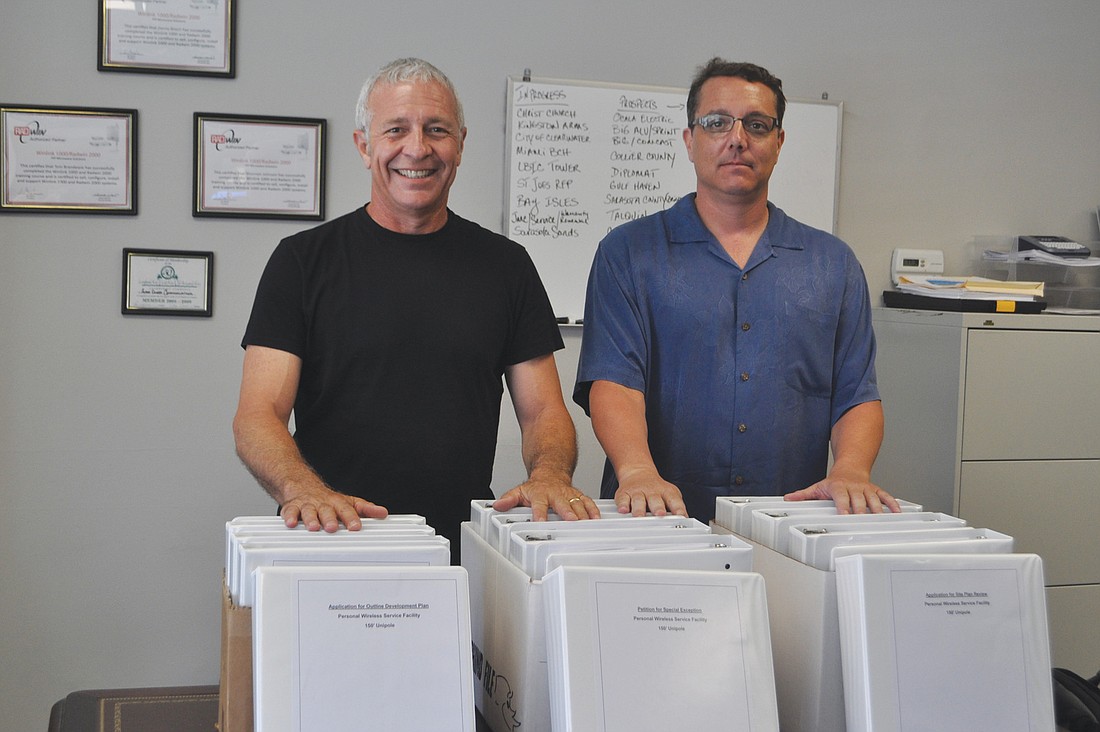- April 25, 2024
-
-
Loading

Loading

Jim Eatrides, of Alpha-Omega Communications Inc., and Kevin Barile, of Ridan Industries II LLC, hope to bring a 150-foot stealth cellular tower to the Longboat Island Chapel. Here, the Eatrides and Barile sound off on their application.
Editor’s note: The views expressed in this Q&A are the opinion of Jim Eatrides and Kevin Barile and are not necessarily the opinion of the Longboat Observer.
Many alternative sites for a proposed tower have been suggested: Coquina Beach, the Longboat Key Public Works site and the Longboat Key Police/Fire Rescue property. Why the Longboat Island Chapel site?
Coquina Beach is too far north and doesn’t provide the proper radio-frequency coverage for what the north end needs. The police/fire property is too far south. The only two properties that have the institutional zoning required by town code for a cellular tower are the chapel and the Public Works site, which is a much smaller site than the chapel property.
Why not bring a distributive antenna solution (DAS) to the island?
DAS is great. It’s just not appropriate for this island because of the low population density. It’s technically feasible, but there’s not the type of population to support the costs, which are approximately 10 times that of a cell tower ($3 million vs. $300,000). The fibers cost approximately $35 per foot and would have to run the length of the north end plus through side streets.
What about femtocells and light-cube radios?
Femtocells connect through your broadband network and work well for people in their homes, but they don’t work for outdoor coverage or for people with a different carrier. Femtocells also cause interference. For example, if you go out in your lanai, you often get a weak signal from your femtocell and a weak signal from the tower across the bay, which confuses the phone, causing it to drop the signal. It’s not a mass-market solution. Light-cube radios are small antennae that will allow more capacity but still require towers to work.
Could a shorter tower work?
Verizon, our lead carrier, in order to meet its design standards in terms of indoor and outdoor coverage needs to be elevated to at least 110 feet. But you also need diversity because not everyone has the same carrier. At a height of 150 feet, the tower would provide space for six providers.
What happens to the tower if technology changes and cellular towers become obsolete?
Town code requires that it would be taken down. We’ve posted a tower-removal bond that would pay for the removal in the event that it is no longer needed and we don’t have the capacity to remove it, which is often required by municipalities.
How will you address the visual impact?
There are two ways to deal with it: You can minimize it, which is what we’ve chosen with the stealth, “flagless flagpole design.” (According to Barile, many communities that have placed a flag on the structure have later removed it because of the noise generated when it flaps in the wind.) It’s a grayish color that will blend in with the skyline. The other alternative is to make it stand out as a landmark. We could do something to make it stand out by designing it as a lighthouse or Greek column, for example, or consulting with skilled designers, such as those at the Ringling College of Art and Design.
Where does the application currently stand?
We have submitted the materials we agreed to turn in at the Nov. 10 Longboat Key Zoning Board of Adjustment hearing and received staff comments Dec. 8. We’ll submit the items they asked for, such as a geotechnical report and dewatering plan for the anticipated groundwork shortly. But we’re inclined to work with the town and not start the “shot clock” (the 90 business-day period Florida municipalities have to approve or deny a cellular tower from the time the application is determined to be complete), until the consultant the town hires has completed a wireless communications study. We agree with our opposition on the decision to hire a consultant. We’re also waiting for the town’s Comprehensive Plan to be updated to include definitions of heights.
What is the timetable that you envision for the plan?
The consultant’s report could be done in March, so that we would go before the Longboat Key Planning & Zoning Board again in March or April and then go before the Longboat Key Town Commission in May or June. Before the building permit could be issued, it would take another two to three months to get the final zoning approval, which would run simultaneously with the approximately five months required to get an extra approval required by the Federal Communications Commission to build in a flood plain.